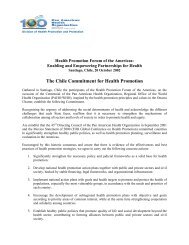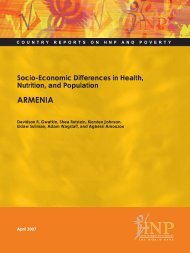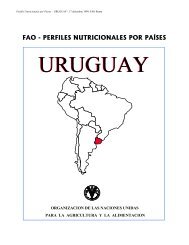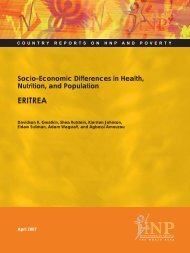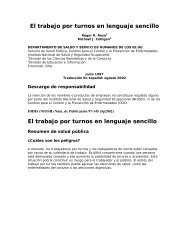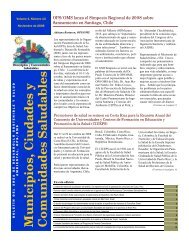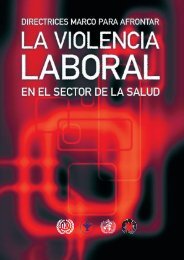Guidelines for drinking-water quality. Volume 1 - BVSDE
Guidelines for drinking-water quality. Volume 1 - BVSDE
Guidelines for drinking-water quality. Volume 1 - BVSDE
You also want an ePaper? Increase the reach of your titles
YUMPU automatically turns print PDFs into web optimized ePapers that Google loves.
facilities and expertise as well as the appropriate legislative framework.<br />
The judgement of safety - or what is an acceptable level of risk in particular circumstances - is a<br />
matter in which society as a whole has a role to play. The final judgement as to whether the<br />
benefit resulting from the adoption of any of the guideline values given here as standards justifies<br />
the cost is <strong>for</strong> each country to decide. What must be emphasized is that the guideline values have<br />
a degree of flexibility and enable a judgement to be made regarding the provision of <strong>drinking</strong><strong>water</strong><br />
of acceptable <strong>quality</strong>.<br />
Water is essential to sustain life, and a satisfactory supply must be made available to consumers.<br />
Every ef<strong>for</strong>t should be made to achieve a <strong>drinking</strong>-<strong>water</strong> <strong>quality</strong> as high as practicable. Protection<br />
of <strong>water</strong> supplies from contamination is the first line of defence. Source protection is almost<br />
invariably the best method of ensuring safe <strong>drinking</strong>-<strong>water</strong> and is to be preferred to treating a<br />
contaminated <strong>water</strong> supply to render it suitable <strong>for</strong> consumption. Once a potentially hazardous<br />
situation has been recognized, however, the risk to health, the availability of alternative sources,<br />
and the availability of suitable remedial measures must be considered so that a decision can be<br />
made about the acceptability of the supply.<br />
As far as possible, <strong>water</strong> sources must be protected from contamination by human and animal<br />
waste, which can contain a variety of bacterial, viral, and protozoan pathogens and helminth<br />
parasites. Failure to provide adequate protection and effective treatment will expose the<br />
community to the risk of outbreaks of intestinal and other infectious diseases. Those at greatest<br />
risk of <strong>water</strong>borne disease are infants and young children, people who are debilitated or living<br />
under unsanitary conditions, the sick, and the elderly. For these people, infective doses are<br />
significantly lower than <strong>for</strong> the general adult population.<br />
The potential consequences of microbial contamination are such that its control must always be<br />
of paramount importance and must never be compromised.<br />
The assessment of the risks associated with variations in microbial <strong>quality</strong> is difficult and<br />
controversial because of insufficient epidemiological evidence, the number of factors involved,<br />
and the changing interrelationships between these factors. In general terms, the greatest<br />
microbial risks are associated with ingestion of <strong>water</strong> that is contaminated with human and animal<br />
excreta. Microbial risk can never be entirely eliminated, because the diseases that are<br />
<strong>water</strong>borne may also be transmitted by person-to-person contact, aerosols, and food intake; thus,<br />
a reservoir of cases and carriers is maintained. Provision of a safe <strong>water</strong> supply in these<br />
circumstances will reduce the chances of spread by these other routes. Waterborne outbreaks<br />
are particularly to be avoided because of their capacity to result in the simultaneous infection of a<br />
high proportion of the community.<br />
The health risk due to toxic chemicals in <strong>drinking</strong>-<strong>water</strong> differs from that caused by<br />
microbiological contaminants. There are few chemical constituents of <strong>water</strong> that can lead to acute<br />
health problems except through massive accidental contamination of a supply. Moreover,<br />
experience shows that, in such incidents, the <strong>water</strong> usually becomes undrinkable owing to<br />
unacceptable taste, odour, and appearance.<br />
The fact that chemical contaminants are not normally associated with acute effects places them<br />
in a lower priority category than microbial contaminants, the effects of which are usually acute<br />
and widespread. Indeed, it can be argued that chemical standards <strong>for</strong> <strong>drinking</strong>-<strong>water</strong> are of<br />
secondary consideration in a supply subject to severe bacterial contamination.<br />
The problems associated with chemical constituents of <strong>drinking</strong>-<strong>water</strong> arise primarily from their<br />
ability to cause adverse health effects after prolonged periods of exposure; of particular concern<br />
are contaminants that have cumulative toxic properties, such as heavy metals, and substances<br />
that are carcinogenic.




